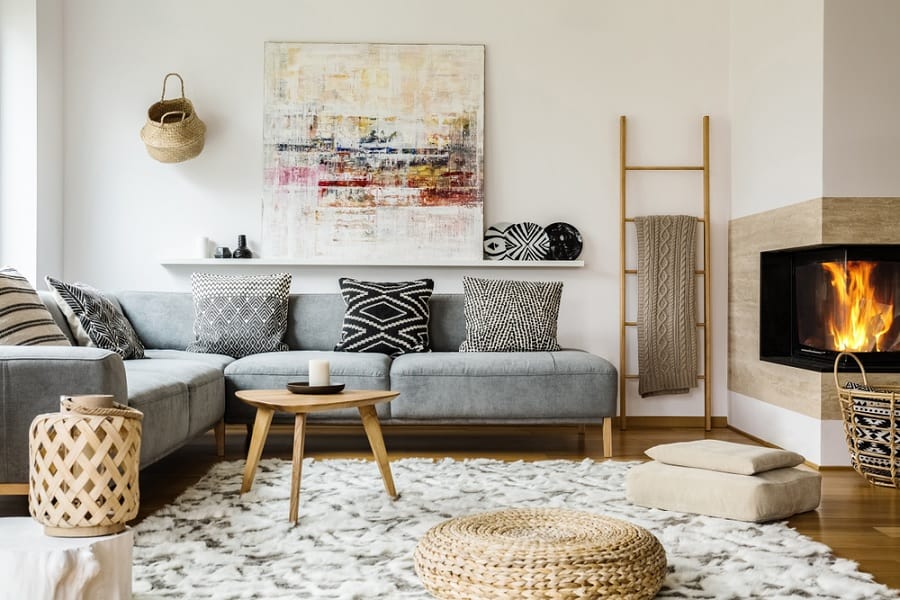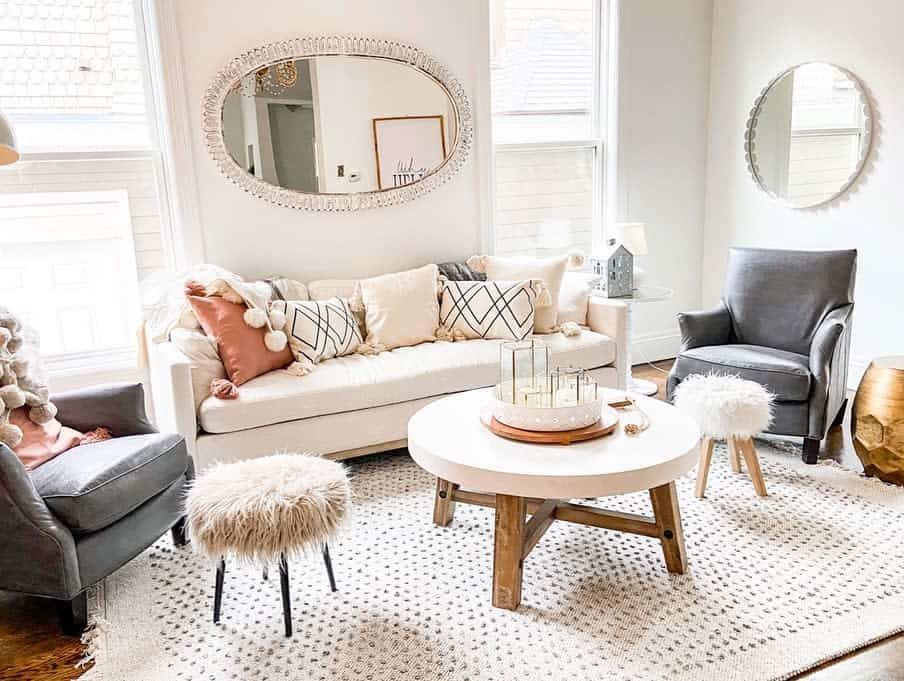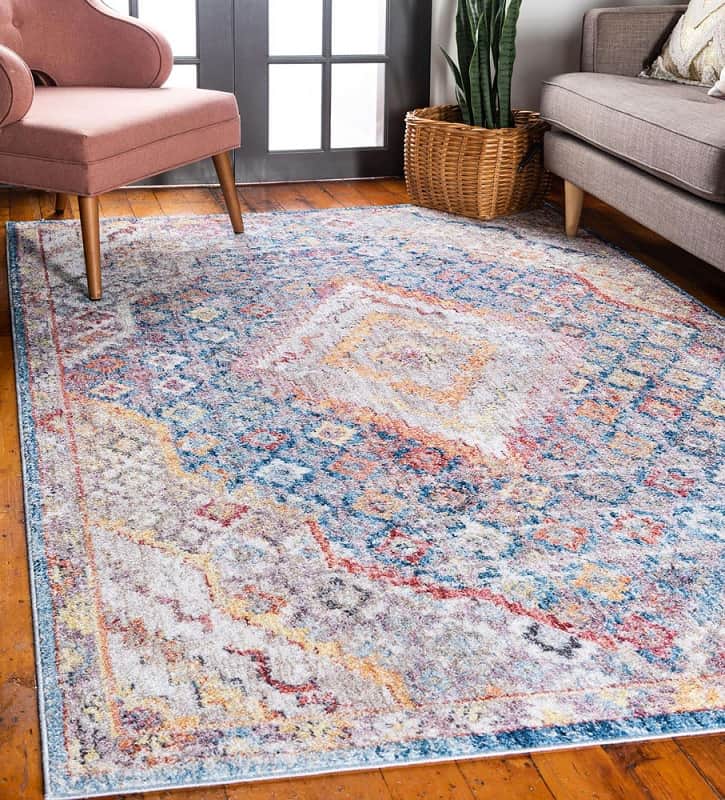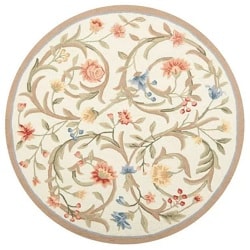
How to Place a Rug in a Living Room
It is one of the most commonly faced dilemmas in home decorating; how to place a rug in a living room. Getting it right enhances your living room while getting it wrong can make the space feel awkward, cramped, and uncomfortable.
So, whether you are starting from scratch or doing a little redecorating, this guide will help you perfectly place your rug.
Choose the Right Size

Before you start figuring out living room arrangements, you need to take a step back and make sure you have the right rug size.
The perfect rug will enhance the room, making it feel more spacious, welcoming, and tied together. Unfortunately, people often underestimate the size of the area rug they need. So, when in doubt, always go with the bigger rug.
Unless your rug is curling up the walls, no one walks into a room and thinks, “gee, they bought a really big rug!”. However, even those not well versed in design will notice the awkwardness of a too small rug, even if they can’t articulate that the small rug is what makes the room feel awkward.
Buying a rug that is too small makes the living room feel smaller than it really is because it creates an unnatural visual line that breaks up the space. This also makes the room feel choppy, which makes it awkward to be in.
Finally, it brings down the quality, making the room feel cheap. The lack of design and forethought is a dead giveaway that someone other than a professional designed the room.
Rugs Size Guide
As a general rule, the majority of American homes have a living room that is large enough to support an 8 x 10 foot rug like this nuLOOM Ren Machine Washable Vintage Floral Area Rug. Unless your living room is unusually tiny, do not buy a rug under 6 x 9 feet. A 4 x 6 rug is simply too small for any living room in a home. Instead, save these smaller rugs for your bedroom, bathroom, or home office.
You Bought Small
If it is too late and you have already bought a small rug, there are a few things you do with it. This will save you from having to buy a new rug right away. Large rugs can be expensive. Try centering the small rug under the coffee table or a small table.
Consider layering the rug with another one underneath it. For example, your first rug is a lovely handwoven 4 x 6 that you picked up while traveling or is a family heirloom.
Place a jute or seagrass rug like the nuLOOM Elijah 9 x 12 Beige Solid Area Rug underneath for textural and color contrast. They are more affordable than other large rugs, and the two rugs create a purposeful feel to the smaller one.
Center the Rug
You shouldn’t position your rug so it is in the center of the entire room. Your rug placement needs to make sense with the positioning of the furniture.
As mentioned earlier, you can center a small rug under the coffee table. A larger rug should be positioned to coordinate with the largest furniture piece in the room. This is typically the sofa.
If you have two sofas, you should center the rug between the two. This may or may not be the center of the room. For example, if you have a sectional sofa that creates an L or U shape, the rug should be centered so that it is not longer on one side.
All Legs Off
Taking an all legs off approach works well in a small living room because it helps a small space to feel more open. The trick is placing the rug so that the edge of the rug just meets the front legs of the sofa.
This showcases the beauty of a patterned rug and makes it the focal point in the room. A smaller rug that does not meet the front of the furniture will not have the same effect and can lead to the choppy effect mentioned earlier.
All Legs On
For a living room that looks professionally designed, buy a larger rug that you can place all four legs of your furniture on. The rug needs to be large enough that it extends several inches or up to a foot beyond the outside legs.
The only exception is if your sofa is against the wall, then you would line both the rug’s edge and the sofa up with the wall. The all legs on approach works best in large living rooms or ones with an open floor plan.
This approach creates a visual zone, helping to define the living room space from the rest of the home.
If you have more than a sofa in your living room, this is an all or nothing approach. The rug should be large enough to position all of the furniture fully on it.
This includes multiple sofas or a sofa and accent chair combination. If the rug is not large enough for this, then scale back and position only the front legs of all of the furniture on the rug.
Front Legs On

If you do not have the budget or living space for the all legs on approach, then you can cheat by only putting the front furniture legs on the rug. The rug needs to be big enough that you won’t see the edge when it is tucked under. It also needs to extend beyond the sides of the sofa. This defines the seating area without overwhelming a smaller room.
Rounded
The traditional rule of vintage rugs is to choose a rug shape that matches the shape of the room. This helps create visual flow by creating parallel lines. The long lines of the walls match the long lines of the rectangular rug.
However, modern rules tend to put this aside for differently shaped rugs. Instead of using a square rug in a square room, try using a circular rug like this SAFAVIEH Chelsea Ivory Round Floral Border Solid Area Rug.
The curves of the round rug will create a unique visual effect that can soften the harsh corners of the room. It can also work well in a room that does not have a clearly defined shape.
Fully Cover High Traffic Areas
When choosing your living room rug size and placement, think about where people will walk through your living room.
The rug should either cover the entire walking path or leave it completely bare. You shouldn’t walk through with one foot on the rug and the other on the bare floor. This will feel awkward underfoot.
Leave Equal Space
Interior designers will tell you that the rules state that you should have about 8-12 inches of space on either side of the rug from the wall. However, this can vary greatly when you buy a larger rug.
Traditional rugs on hardwood floors can leave as little as 4-6 inches of space from the wall. The amount of space is not as important as it is equal.
The goal is to create a balanced look. If the rug covers the entire floor, look at the space between the edge of the rug and the wall.
If your rug is smaller, look at the amount of rug that extends beyond each end of the rug. If your rug is between multiple pieces of furniture, it should be equally positioned between them.
Use Multiple Rugs
The idea of layering rugs is relatively new in mainstream interior design. There are a couple of ways you can go about it. The first is simple, have two rugs that are the same shape, with one larger than the other.
Place the smaller rug centered on top of the larger one. Then arrange them as we described above. Typically, people choose a plain rug for the larger one because the majority of it will be covered. Then the top smaller one is more creative.
For example, it could be a patterned or colorful rug. You can skip the rug pads with this approach. The multiple rugs will feel thick like carpet, especially if you use wool rugs.
The other approach requires a bit more finesse and is harder to pull off. Buy several rugs that would be too small on their own, and then position them together.
This works well for Moroccan rugs like this Bungalow Rose Heba Moroccan Area Rug. You could position them with front legs on for each piece of seated furniture.
Or you could angle them haphazardly at 45-degree angles to cover the entire floor. This placement looks beautiful with bohemian decor or a nontraditional seating arrangement.

